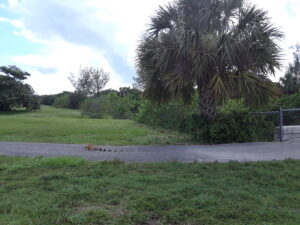
Deerfield-News.com-Deerfield Beach, Fl-While the FWC, has done a walk back on it’s “kill them where you can”. Local “Homeowners Associations” are finding bullet holes fired into their common area property. Citizens have been following Floridas FWC declaration of open season on Green Iguanas and in some cases shooting people and property. Florida’s lack of specificity on how to humanely kill and dispose of the Green Iguana is the problem. Florida has created an “OK Corral” effect on the killing of the Green Iguanas, the State of Florida FWC gets an F for their original instructions and suggestions to the public.
Local iguana control companies have reported an uptick in complaints they claim are being caused by armed citizens shooting iguanas where they find them. In most cases leaving the dead animals and not disposing of them. Some complain that the Intracoastal waterway is being inundated with “FLOATERS”, the carcasses of dead iguanas floating as a result of property owners shooting them dead where they found them.
Here is the FWC’s most recent post on Green Iguanas which seems to have changed significantly.
Regulatory Status
 Green iguanas (Iguana iguana) are an invasive species in Florida and are not native to our state. They can cause considerable damage to infrastructure, including seawalls and sidewalks. This species is not protected in Florida except by anti-cruelty law.
Green iguanas (Iguana iguana) are an invasive species in Florida and are not native to our state. They can cause considerable damage to infrastructure, including seawalls and sidewalks. This species is not protected in Florida except by anti-cruelty law.
Captive held iguanas are regulated as Class III wildlife in the State of Florida. A permit is not required to possess green iguanas as personal pets. However, a License to Possess Class III Wildlife for Exhibition or Public Sale must be obtained to possess these reptiles for commercial use and a Captive Wildlife Importation Permit is required to import this species into the state.
Description
 Green iguanas are large, typically green lizards, though they can sometimes be brown or almost black in color. Some adults can take on an orange or pink coloration during certain times of the year. Hatchling and young green iguanas usually have bright green coloration.
Green iguanas are large, typically green lizards, though they can sometimes be brown or almost black in color. Some adults can take on an orange or pink coloration during certain times of the year. Hatchling and young green iguanas usually have bright green coloration.
Green iguanas have a row of spikes down the center of the neck, back, and upper portion of the tail, and have dark black rings on the tail. Mature male iguanas develop heavy jowls and a throat fan (or dewlap) that are much larger than those of female iguanas. Larger throat fans can make male iguanas appear bigger, repel rivals, or warn predators. Female iguanas may choose to breed with male iguanas that have larger dewlaps. The throat fan can also help iguanas regulate body temperature.
Male green iguanas can grow to over five feet in length and weigh up to 17 pounds. Females can also reach five feet in length but usually do not exceed seven pounds. Females typically reach reproductive maturity at two to four years of age. Green iguanas typically mate in October through November in their native range, and nesting occurs on riverbanks, beaches and other sandy areas. Females dig egg chambers that may contain nearly 80 feet of interconnected tunnels and multiple entrances and lay clutches of anywhere from 14-76 eggs. Green iguanas can live up to 10 years in the wild and 19 years in captivity.
Green iguanas can live on the ground, in shrubs, or in trees in a variety of habitats including suburban developments, urban areas, small towns, and agricultural areas. They are excellent swimmers, tolerating both salt and freshwater and can submerge themselves for up to four hours at a time.
Diet
Green iguanas feed on a wide variety of vegetation, including shoots, leaves, blossoms and fruits of plants such as nickerbean, firebush, jasmine, orchids, roses, Washington fan palms, hibiscuses, garden greens, squashes and melons. Their tendency to eat ornamental plants can make them a nuisance to homeowners. Adult green iguanas can also feed on bird eggs and dead animals. Juvenile green iguanas feed on vegetation, insects and tree snails.
Native Range
The native range of green iguanas extends from Central America to the tropical parts of South America and some eastern Caribbean islands.
Florida Distribution
Green iguanas were first reported in Florida in the 1960s in Hialeah, Coral Gables and Key Biscayne along Miami-Dade County’s southeastern coast. Green iguana populations now stretch along the Atlantic Coast in Broward, Martin, Miami-Dade, Monroe and Palm Beach Counties and along the Gulf Coast in Collier and Lee Counties. There have also been reports as far north as Alachua, Highlands, Hillsborough, Indian River and St. Lucie Counties. However, individuals observed in more northern counties are likely escaped or released captive animals and are unlikely to establish populations, as iguanas are not cold hardy. In cleared habitats such as canal banks and vacant lots, green iguanas reside in burrows, culverts, drainage pipes and rock or debris piles. South Florida’s extensive man-made canals serve as ideal dispersal corridors to further allow iguanas to colonize new areas.
Impacts
Green iguanas cause damage to residential and commercial landscape vegetation and are often considered a nuisance by property owners. Iguanas are attracted to trees with foliage or flowers, most fruits (except citrus) and almost any vegetable. Some green iguanas cause damage to infrastructure by digging burrows that erode and collapse sidewalks, foundations, seawalls, berms and canal banks. Green iguanas may also leave droppings on docks, moored boats, seawalls, porches, decks, pool platforms and inside swimming pools. Although primarily herbivores, researchers found the remains of tree snails in the stomachs of green iguanas in Bill Baggs Cape Florida State Park, suggesting that iguanas could present a threat to native and endangered species of tree snails. In Bahia Honda State Park, green iguanas have consumed nickerbean, which is a host plant of the endangered Miami Blue butterfly. As is the case with other reptiles, green iguanas can also transmit the infectious bacterium Salmonella to humans through contact with water or surfaces contaminated by their feces.
Frequently Asked Questions
Can I remove iguanas from my property?
Green iguanas are not protected in Florida except by anti-cruelty laws and can be humanely killed on private property year-round with landowner permission. The FWC encourages removal of green iguanas from private properties by landowners. Members of the public may also remove and kill iguanas from 22 FWC managed public lands without a license or permit under Executive Order 17-11. Captured iguanas cannot be relocated and released at other locations in Florida. Homeowners that trap iguanas on their property may be able to obtain euthanasia services from local exotic veterinarians, humane societies or animal control offices depending on the location and availability of services. If you are not capable of safely removing iguanas from your property, please seek assistance from a professional nusiance wildlife trapper.
How can I deter green iguanas from frequenting my property?
If you have an iguana frequenting your area, you can take steps to deter the animal such as modifying the habitat around your home or humanely harassing the animal. Examples of effective habitat modification and harassment include:
- Removing plants that act as attractants
- Filling in holes to discourage burrowing
- Hanging wind chimes or other items that make intermittent noises
- Hanging CDs that have reflective surfaces
- Spraying the animals with water as a deterrent
View the FWC presentation Iguana Technical Assistance for Homeowners.
What if I own a pet iguana that I can no longer care for?
Escaped or released pets remain a primary source of introduced species in Florida, although it is illegal to introduce nonnative species into the state. Through the FWC’s Exotic Pet Amnesty Program, pet owners who are either unable to care for their exotic pets, such as green iguanas, or who no longer wish to keep them can surrender them with no questions asked and without penalties regardless of whether those pets are kept legally or illegally. Surrendered pets are adopted to new owners who have been pre-qualified and who have any required permits. The EPAP helps reduce the number of nonnative species being released into the wild by pet owners and fosters responsible pet ownership, giving pet owners an ethical and ecologically sound alternative to releasing an exotic animal.




































